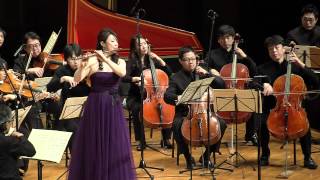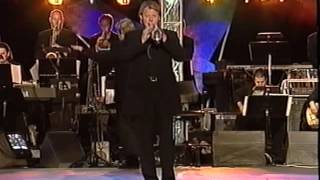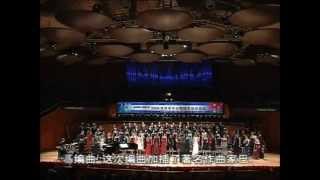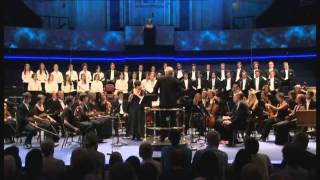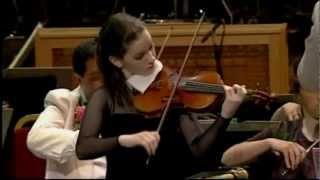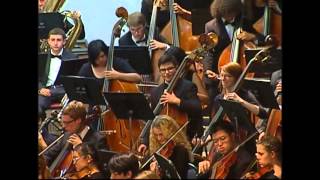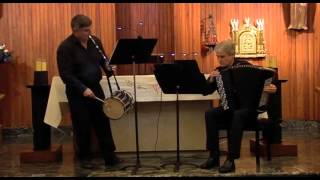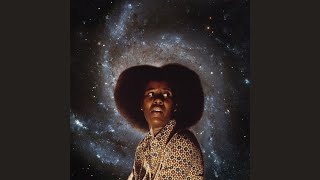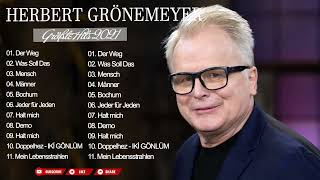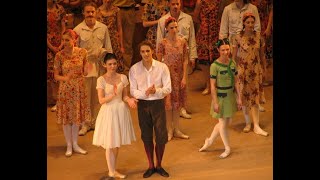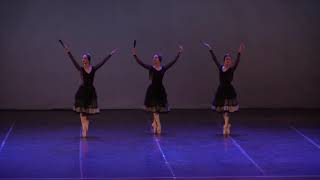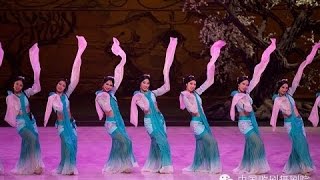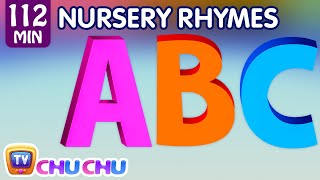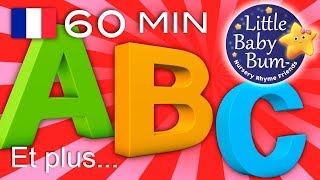Recommended music videos for initiation to classical music
Johann Sebastian Bach (1685-1750) was a German violinist, organist, conductor and composer. He was born in Eisenach into the most prominent musical family in history, with more than 30 famous composers in its midst. In 1703 he obtained his first job as court musician to the Prince of Arndstat and in 1707 he moved to Mülhausen as an organist, where he married his cousin Maria Barbara with whom he had seven children. After the death of his wife in 1720, he remarried Maria Magdalena a year and a half later, with whom he would have another thirteen children. In 1723 he moved to Leipzig , where he would reside until his death at the age of 65. A prolific composer, he is considered one of the three main geniuses in the history of music along with Mozart and Beethoven.
The Suites for Orchestra, BWV 1066–1069 (called ouvertures after their composer), are four pieces by Johann Sebastian Bach , probably composed between 1725 and 1739 in Leipzig . The term ouverture refers only in part to the opening movement in the style of the French Overture , in which a stately opening section in relatively slow duple time is followed by a rapid fugal section in ternary time, then completed by a brief recapitulation of the introductory music. In a broader sense, the term was used in Baroque Germany to refer to a series of dance pieces in the French Baroque style preceded by such an ouverture .
Today we can watch part of the Second Suite for Orchestra (Orchestral Suite No.2 in b minor, BWV1067) ; specifically, the last three movements or dances: Ⅴ. Polonaise (0´2´´) .-. Ⅵ. Minuet (3´24´´) .-. Ⅶ. Badinerie (4´45´´). The suite is written for flute and string ensemble, today with the Korean flutist Yunyoung Lee as soloist.
Luigi Denza (1846 – 1922) was an Italian singing teacher and composer, who achieved great fame for his Neapolitan songs Funiculì, funiculà, Luna fedel and Occhi di fata , among others. He studied at the Conservatory of San Pietro a Maiella in Naples , where his teachers were Paolo Serrao and Saverio Mercadante . In 1876 he premiered his opera Wallenstein in Naples . He was a singing teacher at the Neapolitan conservatory. In 1880 he settled in London (the same year as another Italian songwriter, Paolo Tosti , did so), where he was co-director of the Royal Academy of Music until 1898 and singing teacher at this institution until 1922, when he died.
The Neapolitan song is a composition generally in the Neapolitan language for solo male voice and instrumental accompaniment, characteristic of the city of Naples and its region. Its lyrics refer to love affairs or the landscape of Southern Italy . Some of the most famous songs are O sole mio, Torna a Surriento, Funiculì funiculà or Santa Lucia . The international popularity of Neapolitan songs was due, in part, to Italian emigration to the rest of Europe and America between 1880 and 1920. It also contributed to the interest of opera performers such as Enrico Caruso , who used these songs to perform them as an encore in his performances at the Metropolitan Opera House in New York and to record them on disc.
Funiculì, funiculà is a famous Neapolitan song composed in 1880 by Luigi Denza with lyrics by the journalist Giuseppe "Peppino" Turco . It commemorates the opening of the first funicular to Mount Vesuvius and was sung for the first time at the Quisisana Hotel in Castellammare di Stabia to great acclaim. Today we are listening to its reproduction in a version by the Norwegian trumpeter Ole Edvard Antonsen accompanied by the Jens Wendelboe Orchestra .
Isaac Albéniz (18601 - 1909) was a famous Catalan composer and pianist, a disciple of Felipe Pedrell . Thanks to the help of Guillermo Morphy , Count of Morphy , composer and patron of the arts, he obtained a pension to train at the Brussels Conservatory in 1876, finishing his studies in 1879. Being a virtuoso piano composer, Albéniz also composed music for other instruments and dedicated more than a decade of his almost forty-nine years of life to writing themes for theater, such as his most successful operatic work Pepita Jiménez; he also dedicated himself to performing concerts or recording his opera Merlín . During his career he wrote more than two dozen songs, as well as several orchestral and chamber themes.
Today Alicia de Larroch offers us No. 2 of Six Leaves from Album Spain , Tango (which is actually a habanera), a short but delightfully romantic work and one of our composer's most popular.
Irving Berlin (1888-1989) was a Belarusian -born, American-born Broadway composer and lyricist, one of the most prolific and famous in contemporary American history. Berlin was one of the few Tin Pan Alley/Broadway composers who wrote both the words and music for his songs. Although he never learned to read music beyond an elementary level, he composed around 3,000 songs (other sources estimate 900 songs), many of which became popular songs such as " White Christmas" and " God Bless America ." He produced 17 films and 21 Broadway shows, in addition to his individual songs.
Blue Skies is a folk song, written by Irving Berlin in 1926, one of many folk songs whose lyrics use a "bluebird of happiness" as a symbol of joy; however, the cheerful optimism of the lyrics is undermined by the minor key mode, giving the words an ironic feeling. Today it is brought to us by the Hong Kong World Youth Choir Foundation .
Recommended classical music videos
The catalogue of Bach's works or Bach-Werke-Verzeichnis , better known by its initials BWV , consists of a numbered index of all the composer's works arranged thematically by type of work or genre and according to their vocal or instrumental nature and used by scholars and musicians around the world. This catalogue was created in 1950 by the German musicologist Wolfgang Schmieder .
The Easter Oratorio , BWV 249 is an oratorio written by Johann Sebastian Bach , the first version of which was completed as a cantata for Easter Sunday in Leipzig , 1 April 1725, under the title Kommt, gehet und eilet . It was given oratorio character and a new title in a revision of 1735. In another later version from the late 1740s, the third movement was expanded from a duet to a four-part chorale. Unlike the Christmas Oratorio , it has no narrator, but four characters assigned to each of the voices: Simon Peter (tenor) and John the Apostle (bass), appear in the first duet hurrying to the tomb of Jesus , which they find empty. They find there Mary Magdalene (alto) and "the other Mary", Mary of Cleophas (soprano).
The version we offer today is conducted by British maestro John Eliot Gardiner, famous for his historicist interpretation of Baroque and Classical music with period instruments.
Wolfgang Amadeus Mozart (1756-1791) is considered one of the three giants of musical composition along with Bach and Beethoven . A child prodigy born in Salzburg (Austria), at the age of six he mastered the keyboard and the violin and began to compose. His father, Leopold, took him on exhausting tours of different European courts. A prolific composer (more than 600 works written from the age of five until his death), he cultivated all kinds of musical genres: piano works, chamber music, symphonies, concertante works, choral works, operas... each and every one of them a masterpiece of their genre. His operas The Magic Flute, Don Giovanni, Così fan Tutte, and The Marriage of Figaro are among the 10 most performed operas in the world. He died in Vienna at the age of 35.
The catalogue of Mozart's works or Köchel Catalogue ( Köchel Verzeichnis, in German) was created by Ludwig von Köchel in 1862 and lists the musical works composed by Wolfgang Amadeus Mozart . Each of Mozart 's works is designated by a number preceded by the abbreviation K. or KV ; a number that designates the chronological order of its creation and that is really valid for most of the works although some works by other authors appear .
Hilary Hahn (born 1979) is an American violinist and winner of three Grammy Awards. A child prodigy, she moved to Baltimore , Maryland , at the age of 3, where she began studying violin a month before her fourth birthday at the Peabody Conservatory . In 1991 she made her debut with the Baltimore Symphony Orchestra . Her international debut was in 1995, when she performed Beethoven 's Violin Concerto with the Bavarian Radio Symphony Orchestra under the direction of Lorin Maazel . She has toured the world performing with the London Symphony, the New York Philharmonic, and the Singapore Symphony , among others. Today she does so under the baton of Estonian maestro Paavo Järvi .
The Violin Concerto No. 4 in D major, K. 218 was composed by Wolfgang Amadeus Mozart in 1775, in Salzburg . The concerto has the typical fast-slow-fast structure and is articulated in the following movements: I (0´00´´) ALLEGRO .-. II (9´25´´) ANDANTE CANTABILE .-. III (17´17´´) RONDEAU (ANDANTE GRAZIOSO - ALLEGRO MA NON TROPPO).
Today we can see it with Hilary Hahn accompanied on this occasion by the BBC Symphony Orchestra conducted by maestro Sir Andrew Davis , current musical director and principal conductor of the Chicago Lyric Opera .
Richard Wagner (1813-1883) was a German composer, conductor, poet, essayist, playwright and musical theorist of the Romantic period ; a controversial figure for his anti-Semitic ideas and writings such as “ Judaism in Music ” in which he rails against the musical relationship of Jews with music. In his early days, his works followed the romantic tradition; but later he transformed musical thought with the idea of the “ total work of art ” (Gesamtkunstwerk). His capacity for philosophy, literature, music, performing arts, painting and sculpture is transferred to his operas conceived as an exponent of “ total art ”. With these principles he had the Bayreuther Festspielhaus theatre built so that he could stage his own operas for which he was not only the author of the music, but also the author of the libretto and the set design.
The opera Rienzi, with a libretto written by Wagner himself, is structured in five acts. In April 1839 he had finished the composition of the first two acts; the Overture , whose performance we can see today, was the last thing he composed; he finished it in October 1840. The premiere held in Dresden on October 20, 1842, was well received by the public, despite the fact that the opera lasted six hours. The plot, set in the Middle Ages , is based on the eventful life of the papal notary Cola di Rienzi and his confrontations with the noble classes of the time. Due to its long duration, the opera is rarely performed today. Not so its Overture , which we offer today conducted by Sey Ahn (1986), a Korean maestro, head of the Symphony Orchestra of the Wesleyan University of Illinois .
Gabriel Erkoreka was born in Bilbao in 1969. He studied with Juan Cordero and Carmelo Bernaola at the «Conservatorio Superior JC de Arriaga» and at the «Escuela Superior de Música J. Guridi» obtaining honorary prizes in Composition, Piano and Chamber Music. In 1995 he entered the Royal Academy of Music in London obtaining the RAM Diploma of Excellence (PGDip) and a master's degree with distinction from the University of London . He is a founding member of the Bernaola Trio and associate composer of the group Kantak . In 2001 he was named an honorary associate member of the « Royal Academy of Music » (ARAM), where he taught orchestration classes. He is currently a professor of composition at Musikene , the Superior Conservatory of Music of the Basque Country. In 2001 he received the Prix de Rome , as well as the Composition Prize of the INAEM and the Colegio de España in Paris. He recently received the Reina Sofía Prize from the Fundació Ferrer-Salat .
The Txistu belongs to the European family commonly known as the “Three-hole flute”. It is played with one hand (usually the left), so that the other is free to play the tambourine that hangs from the arm used to play the txistu. Currently tuned in F , it is frequently accompanied by the whistle or txistu haundi , a lower-pitched instrument, tuned in B flat . The txirula , a higher-pitched instrument, which is usually accompanied by the ttun ttun (string drum), belongs to the same family. The txistu is used in pilgrimages, parades, tributes, institutional events and in different types of concerts, both as a solo instrument accompanied by an orchestra, as part of a chamber ensemble or forming a small txistu band , in which case the works are usually written for three voices (1st txistu, 2nd txistu and whistle) with accompaniment by the tambourine and the snare drum, drumstick or snare drum.
The accordion is a wind musical instrument, consisting of a bellows, a fingerboard and two wooden sound boxes. The bellows are closed at both ends by wooden boxes. The right-hand side of the accordion also has a fingerboard with an arrangement of keys that can be like a piano ( piano accordion ) or round keys (also called buttons ); the left-hand side has buttons on both types of accordion to play the bass and accompaniment chords.
Today we offer the work for txistu and accordion Haize-Orratz , a score commissioned by the Berriztu Association of Durango performed by Aitor Amilibia on the txistu and José Antonio Hontoria on the accordion.
Recommended music videos for all tastes
Alice Coltrane (née Alice McLeod 1937 – 2007) was an American jazz composer, pianist, organist, harpist, and singer, one of the few people to have used the harp as a member of a jazz band . Alice was born in Detroit , Michigan , to a musical family; her mother was a church chorister and her half-brother, Ernest Farrow , became a jazz bassist . Encouraged by her father, Alice began playing organ at Mount Olive Baptist Church and later in clubs around Detroit . Her interest in gospel, classical, and jazz music led her to create her own innovative style, moving away from the mainstream jazz style toward a more cosmic and spiritual vision. In 1965 she married John Coltrane and joined his quartet.
Herbert Grönemeyer (born 12 April 1956) is a German musician, singer and actor. Since 1984, all of Grönemeyer 's studio albums have reached number one in the German charts. In 1998, his wife Anna and his brother Wilhelm died of cancer within three days of each other. This affected him deeply. His grief was reflected in the songs on his 2002 album Mensch , which has sold 3.7 million copies, making it the best-selling album in German music history. Grönemeyer has also had notable success as an actor. He has appeared in numerous German films, of which Wolfgang Petersen 's Das Boot was an extraordinary international success.
Lali Espósito (Buenos Aires; October 10, 1991) is an Argentine actress, singer and songwriter. She began acting as a child in the early 2000s in various children's and youth programs (2003-2006). She became known for her character Marianella Rinaldi in Casi ángeles (2007-2010) and as a member of the pop band derived from the series, Teen Angels , with which she recorded six studio albums, three live albums and the documentary Teen Angels: el adiós 3D . She continued her career in television with supporting roles (2013-2014) and obtained her first leading role in Esperanza mía (2015-2016). Since 2013, she is also a solo singer. Her first song, " A bailar ", was released at the end of that year and the eponymous album, in 2014. Subsequently, she released Soy (2016), Brava (2018), Libra (2020) and Lali (2023).
Hagibis was a famous Filipino rock group nicknamed the Village People of the Philippines . Their success in the 1960s, 1970s and 1980s contributed to the evolution of Pinoy rock and roll as well as the fusion of musical genres known as the " Music of the Philippines " (OPN). Hagibis was formed in Manila in the late 1970s; the band initially consisted of Bernie Fineza, Mike Respall, Sonny Parsons, Joji Garcia and Mon Picazzo ; Mike Hanopol was Hagibis ' teacher and songwriter, best known for his image and songs as were other famous acts such as Katawan and Lalake .
Recommended peculiar videos
The Bright Stream , Op. 39, is a ballet in 3 acts, 4 scenes, composed by Dmitri Shostakovich to a libretto by Adrian Piotrovsky and Fyodor Lopukhov , with choreography by Fyodor Lopukhov . It premiered at the Mikhaylovsky Theatre in Leningrad in 1935.
The plot centers on a group of ballet dancers who have been sent to provide entertainment on a new Soviet collective farm. The workers are especially welcoming to the group's dancer, Zina 's former dance teacher, who introduces her to her husband, Pyotr , who immediately begins flirting with the dancer. Hurt, Zina withdraws from the celebrations and is comforted by the dancer. The dancer suggests a plan where she will dress as her dance partner, while her dance partner will dress as a dancer and Zina will dress as a dancer. Pyotr is tricked into realizing his mistake.
Today we attended the performance of the first act of this ballet offered by Natalia Osipova in the role of Ballerina and Nina Kaptsova in that of Zina with artists from the Bolshoi Ballet .
Majísimo is a ballet created by Cuban choreographer Jorge García , who took the music of the dances “Catalana”, “Aragonese”, “Andaluza”, “Aubade” and “Navarra”, which are part of the opera El Cid by the French composer Jules Massenet , and created with them a choreography that, through the technique of classical ballet, transmits all the brilliance, mystery and mischief of Hispanic culture. (Extracted from the UNE article)
Today we attended the performance offered on April 13, 2019 at the Mella Theater in Havana by the Majisimo Ballet with choreography by Jorge García , music by Jules Massenet , costumes by Salvador Fernández and the performers Claudia García, Daniela Gómez, Chavela Riera, Ana Zamora, Adrián Sánchez, Alejandro Olivera, Daniel Rittoles and Raúl Abreu .
The Legend of the Kiss is a zarzuela in two acts, divided into three scenes, with a libretto by Enrique Reoyo, José Silva Aramburu and Antonio Paso , and music by the masters Reveriano Soutullo and Juan Vert . It premiered with great success at the Teatro Apolo in Madrid , on Friday, January 18, 1924.
Today the Alhambra Ballet offers us a choreographed version of its famous Intermedio, which was covered, among other artists, by the group Mocedades in the song Amor de hombre .
Chinese dances have a wide range of artistic expressions due to their colors, their studied movements, their diverse origins and the circumstances in which they are performed; they range from popular dances to opera and ballet performances, and can be performed during public celebrations, rituals and ceremonies. Of the 56 recognized ethnic groups in China , each group has its own folk dances and moments to represent them; in addition, there is currently a resurgence and a movement to recover traditional Chinese dances and dances adapted to our times in which the color, the coordination of body movements and the variety of music and dances are highlighted.
Recommended music videos for children
Various Wikipedia articles have been used to write these texts.
The texts of Videomusicalis are written in Basque, Spanish and English.





